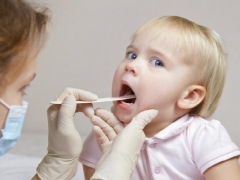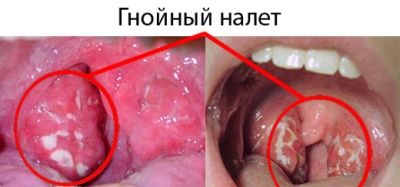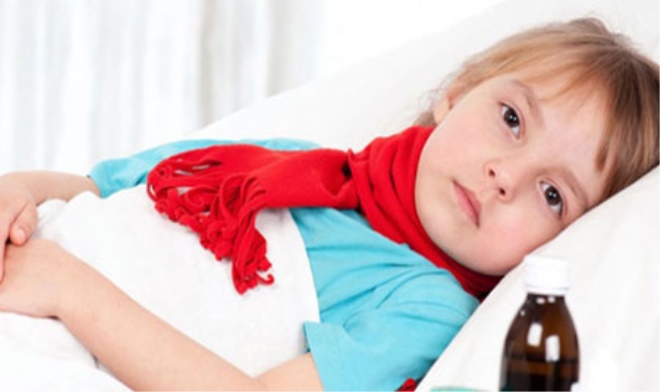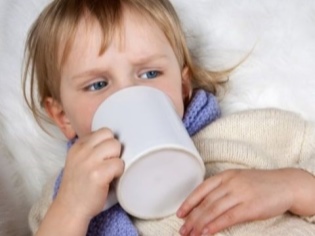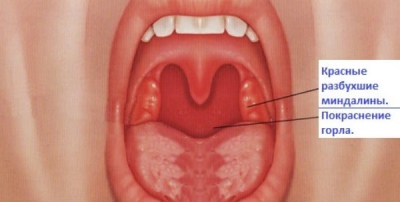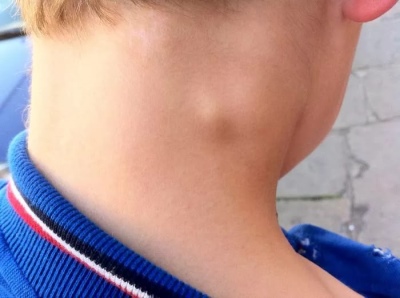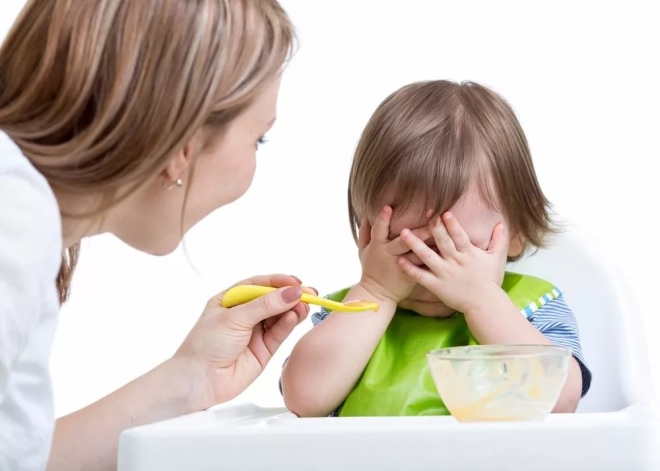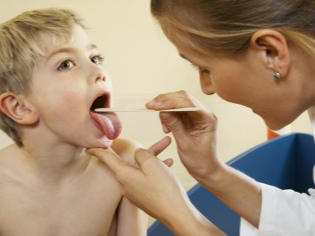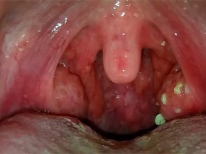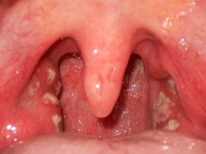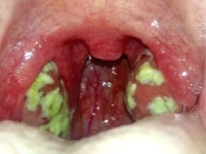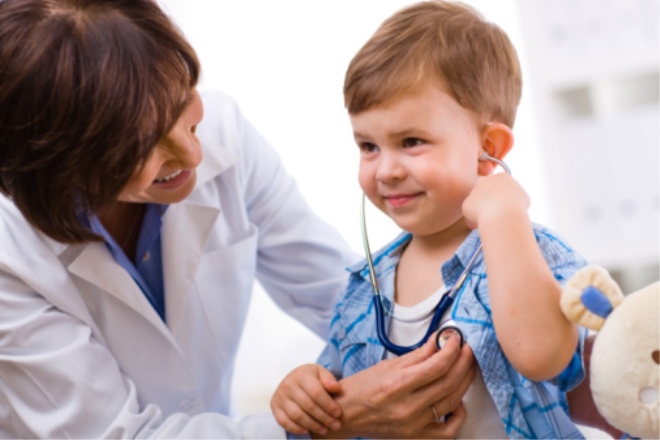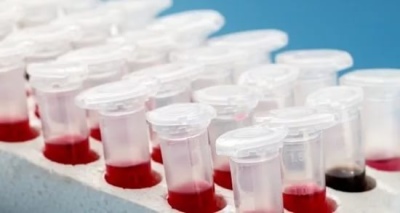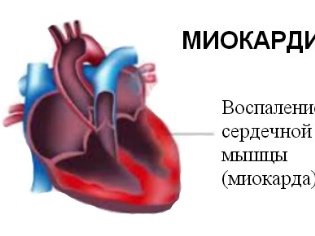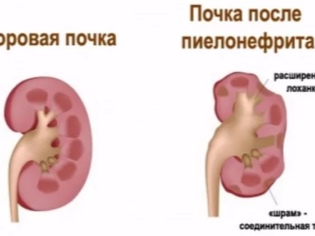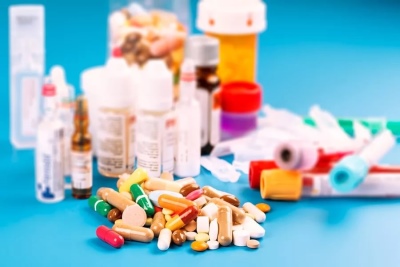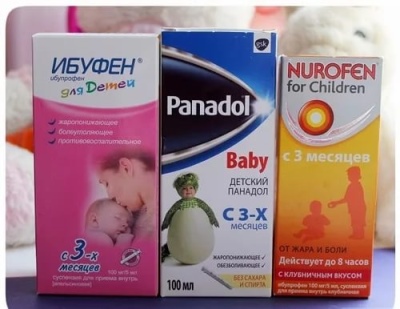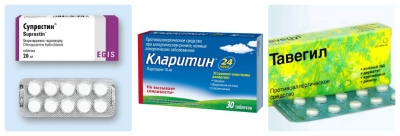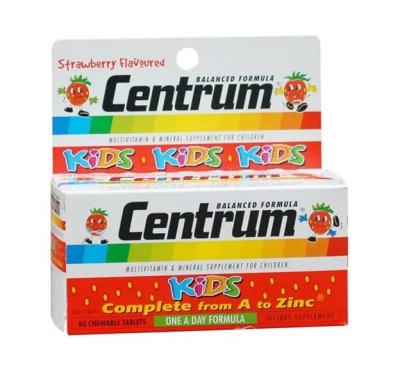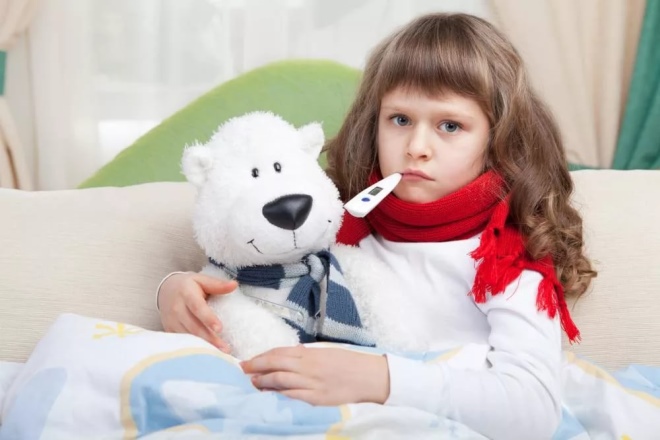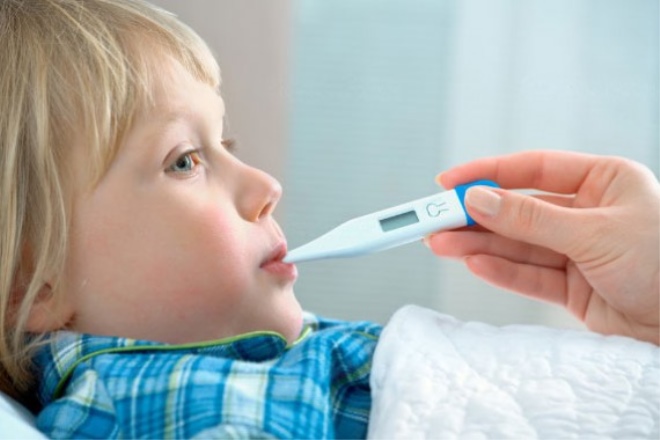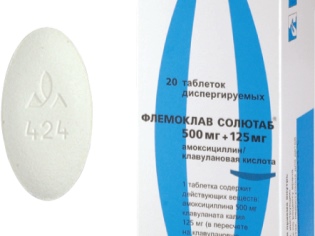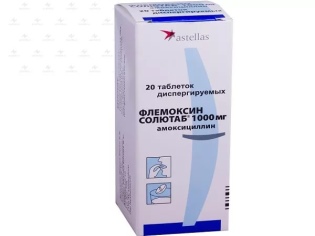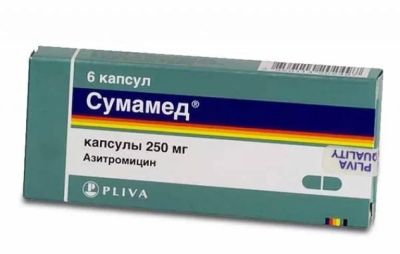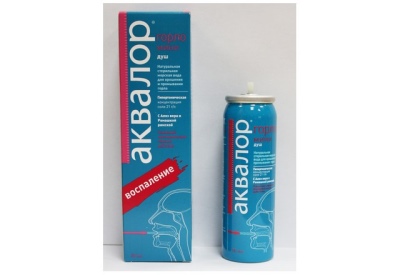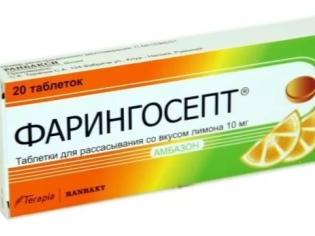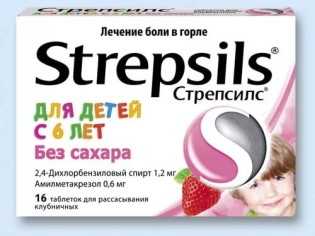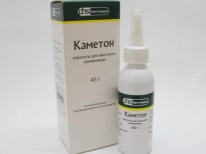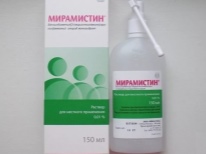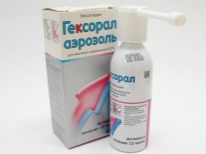Symptoms and treatment of purulent tonsillitis in children at home
Acute tonsillitis, accompanied by the appearance of purulent plaque on the tonsils, has a rather severe course. A sick child feels extremely bad. Adequate treatment is required to eliminate all adverse symptoms. What are the symptoms, how is the treatment of purulent tonsillitis in children at home - many parents ask themselves these questions.
Causes
Most often purulent quinsy or acute tonsillitis causes b-hemolytic streptococcus. Almost 80% of all cases of this disease are caused by this microorganism. Infection with staphylococcal flora also leads to the development of purulent tonsillitis. It causes about 10% of cases. The remaining proportion is in anaerobic microorganisms and a hemophilic bacillus.
In infants the development of acute tonsillitis is almost impossible. This is due to the anatomical feature of the tonsils. Their final formation occurs only in 2 years.
Breast babies also receive protective maternal antibodies that protect them from being infected with angina. Usually, the first cases of disease are recorded in babies 3 years and older.
Incubation period
After the bacteria enters the body, it usually takes some time until the first symptoms of the disease appear. This period is called incubation. For bacterial purulent sore throats, it usually ranges from 5-10 days. In some forms of diseases that are caused by anaerobic microorganisms, the incubation period can be about two weeks.
Symptoms
After the completion of the prodromal period, during which there is a manifold increase in the number of microbes inside the body, specific clinical signs of the disease appear. The degree of their severity may be different. It directly depends on the level of local immunity, the age of the baby, as well as on the presence of concomitant chronic diseases.
Most often, a sore throat develops after a local hypothermia or as a complication of another respiratory infection. In some cases, symptoms may appear during initial infection with viruses. Staphylococcal or streptococcal flora settles easily on inflamed tonsils, which causes further development of angina.
Symptoms of purulent tonsillitis include:
Increased body temperature. It usually increases from 38 to 40 degrees. Against the backdrop of such a condition, a fever or severe chills occur. For purulent tonsillitis usually characterized by severe course with a high body temperature. This symptom is most dangerous in a newborn and one year old child.
- Soreness when swallowing. Any food passing through the sore throat and oropharynx causes pain. Cold and hot drinks only increase pain.
- Redness of the throat and the presence of purulent plaque on the tonsils. The palatine arches slightly increase in size and become swollen. As a result, the entrance to the pharynx narrows noticeably.
- Enlarged cervical, occipital and parotid lymph nodes. They become compacted. Lymph nodes are strongly soldered to the skin.In some cases, when viewed visually, the lymph nodes protrude strongly above the skin surface and are well distinguished.
- Great weakness and loss of appetite. Kids almost completely refuse to eat. Children become more capricious, whimper. In the first days of the disease, drowsiness and apathy towards others are greatly increased.
What does a sore throat look like?
The following signs are characteristic of purulent tonsillitis:
- Swelling and enlarged tonsils. They can grow in size up to two times. Tonsils become dense, bright red. When you try to touch a spoon or a spatula, severe pain occurs.
- The appearance of purulent plaque. It is usually located on the outer surface of the tonsils.
In case of severe disease or gangrenous form of angina, pus may also be inside. The affected amygdala becomes rounded; it is many times larger than the similar one on the other side. Purulent plaque is difficult to separate from the surface and has a pale yellow color.
- Strong smell. When attempting to touch the tonsils, pus may leak out. It has a putrid odor and is usually excreted in a small amount.
- Swelling and swelling of the palatine arches. Normally, these formations are almost impossible to notice. During inflammation, the palatine arches become bright red and hang heavily above the mouth opening.
- Puffiness of the palate. It becomes bright red. Any attempts to touch the palate with a spatula lead to increased bleeding.
How long does the temperature last?
For purulent angina is characterized by a rather severe course. Usually, elevated body temperature lasts for 4-5 days. In the first couple of days, it rapidly rises to 38-40 degrees. In the following days, body temperature gradually decreases to subfebrile values. Full normalization occurs by the end of the first week of illness.
Diagnostics
When the first signs of angina appear or even if there is increasing pain when swallowing, you should definitely show the baby to the doctor.
The doctor will conduct a clinical examination. This will reveal the presence of acute tonsillitis in a child. To clarify the cause, which contributed to the appearance of purulent plaque on the tonsils, the doctor will recommend additional tests.
A blood test is performed for all babies with acute purulent tonsillitis.
It helps to establish the severity of the condition, and also sets viral or the bacterial nature of the disease.
With purulent tonsillitis, the total number of leukocytes increases. The level of stab neutrophils increases, the lymphocytes decrease somewhat. Sore throat is also characterized by accelerated ESR.
Even during the first visit, the doctor will take a smear from the baby. This will be needed to accurately determine the causative agent. Such a study is necessarily conducted for all children with acute tonsillitis. The causative agent of the disease will be installed in the laboratory: a virus, bacteria or fungi. This analysis also eliminates dangerous childhood diseases: diphtheriaI, scarlet fever (similar symptoms).
Complications
Purulent tonsillitis is dangerous by the development of numerous complications. They can occur both in the first days of the disease, and after several months or years. In severe cases of the disease, pus flows into other organs and spreads through the lymphatic vessels. This leads to the development of purulent abscesses and even cellulitis. If pus falls into the mediastinum, the inflammatory process will begin in the internal organs.
The most serious complication is sepsis. This is the spread of bacteria throughout the bloodstream. In this case, microbes get into almost all internal organs.
As a result, this condition leads to a drop in blood pressure and the development of septic shock. It requires intensive treatment, which can only be carried out in the intensive care unit.
Among long-term complications, inflammation and damage to the kidneys or heart muscle are most common. In some children who suffered from purulent tonsillitis in childhood, doctors discover chronic pyelonephritis or myocarditis in adolescence.
These conditions are quite difficult. In such cases, consultation with a nephrologist and a cardiologist is required.
Treatment
Quickly cure purulent sore throat will not work. Usually, therapy for this disease takes about 10-14 days. During this time, the body is completely cleared of bacteria, the normal functioning of the immune system and all the adverse symptoms disappear.
To cope with a sore throat, you should use the whole complex of medical procedures. Even a simple daily regimen and nutrition in the treatment of acute tonsillitis play a very important role.
The complex treatment of purulent tonsillitis includes:
- The use of antibacterial agents. They are needed in order to completely eliminate the pathogenic bacteria from the children's body. Appointed for 7-10 days. Before the antibiotic therapy and on the seventh day from the start of treatment, a complete blood count is monitored. This helps to know if there is an effect from the use of drugs.
- Appointment of antipyretics. They are applied only when the temperature rises above 38 degrees. Paracetamol-based or ibuprofen-based products are optimal for babies. These funds are not assigned to a permanent reception. Usually antipyretic enough for the first days of the disease, since then the temperature does not exceed subfebrile values.
- Therapeutic rinses. It is carried out 3-4 times a day. Suitable for kids over three years old. By this age, the child should be able not to swallow the medicine for a few minutes. Home-made chamomile or sage decoctions, as well as a solution with hydrogen peroxide or "Dioxidine».
- It is prohibited to independently remove purulent plaque from the tonsils. Treat tonsils in this way is not worth it. This can lead to additional trauma to the inflamed mucosa, as well as to infection on open surfaces.
- Antihistamines. Helps to eliminate pronounced swelling of the throat, tonsils and palatine arches. Appointed for 5-7 days, they are usually taken 1-2 times a day. Suitable means approved for use for children. These include "Claritin"," Suprastin ","Loratadine" other.
- Plentiful warm drink. Very good if the drinks contain a lot of ascorbic acid. For this perfect cranberry, lingonberry, lemon, black currant. Homemade fruit drinks and fruit drinks, as well as tea with honey will be good sources of liquid and vitamin C.
Such drinking will help eliminate bacterial toxins from the patient's body and accelerate recovery.
- Multivitamin complexes. A large number of trace elements and vitamins contained in them will help to restore strength and strengthen the immune system.
- Gentle food. All dishes should be at a comfortable temperature. Not allowed too hot or very cold foods. It is better to cook the food in a gentle way: bake, simmer or steam. Before serving, grind or chop with a blender.
- Bed rest
In order for the baby to recover quickly and he did not develop dangerous complications of the disease in the future, he must be in bed during the entire period of high temperature.
Usually this time is at least 4-5 days.
- Limit active walks. Walking with a child during sore throat should be only after the normalization of body temperature. Walking can be resumed by the end of the first week since the onset of the disease. For them, you should choose warm and comfortable clothes. It is better to cover the neck with a warm scarf.
- Do not use warming compresses around the neck. This can lead to the spread of purulent inflammation to other organs. Often the use of warming compresses contributed to the development of abscesses and lymphadenitis.
Antibiotics
For the treatment of purulent forms of angina, various antibacterial drugs are used. The preference is given to means with a wide spectrum of action. They effectively cope with different groups of pathogens. Antibiotics are usually prescribed for 7-10 days.
The first control of the effectiveness of the prescribed antibacterial agent is carried out for 3-4 days from the beginning of the disease. It is quite easy to do it yourself, at home. By this time, on the background of taking the medication, the baby should have normalized or significantly decreased body temperature, as well as decreased pain in the throat.
Purulent attacks can persist in the mouth up to 5-7 days. With a complicated course of the disease - even up to two weeks. The second control of the effectiveness of antibiotics is carried out on the seventh day of the disease. For this, a complete blood count is performed. Leukocytosis and ESR is reduced, and an increased number of band neutrophils is normalized.
Among the antibacterial drugs for the treatment of purulent tonsillitis, the following drugs are especially popular:
· Clavulanic acid-protected penicillins. Appointed for 7-10 days. These include "Amoxiclav"," Augmentin ","Ecoclav"," Flemoklav "," Solyutab "and others.
· Dosage and frequency of use are calculated individually by the attending physician, taking into account the weight of the baby, his age, and the severity of the disease. Macrolides: "Hemomycin», «Sumamed"," Azitroks ". These drugs help to cope with different bacterial flora. They are usually prescribed for 3-5 days.
· Preparations of the cephalosporins group. These funds are usually prescribed in the form of injections. Most often written out for 7-10 days. These include "Cephalosporin", "Ceftriaxone"," Cefipim "and others. They have side effects, so they should be prescribed only by a pediatrician.
How to gargle?
Various rinses are perfect for reducing the inflammation on the tonsils. They can be carried out only for kids from three years. Before the procedure, the child should be explained in detail what needs to be done. Particular emphasis is placed on the fact that the baby should not swallow water with medicine while it is in his mouth.
Broths made from chamomile and sage are considered to be the best rinse for children. These plants have a good antiseptic effect and help relieve inflammation from irritated mucous membranes.
Gargling should be every 3-4 hours. The temperature of the rinse should not be above 50 degrees so as not to burn the damaged sore throat and tonsils.
For rinsing suitable solutions with the addition of hydrogen peroxide, soda or sea salt. The concentration of such funds should be minimal.
If a child has chronic inflammatory diseases of the upper respiratory tract, a doctor should be consulted before rinsing. In some cases, this can lead to the spread of infection and deterioration of health.
Painkillers
These tools are used to eliminate sore throat. They provide a pronounced antiseptic and bactericidal effect, helping to eliminate pathogenic bacteria. Anesthetic lozenges should not be taken thoughtlessly. These medicines also have a number of contraindications and should be taken only on prescription.
All babies with a tendency to develop allergic reactions should use the lozenges with caution. The flavoring and aromatic additives added to them can cause manifestations of allergy in the child.
Anesthetic lozenges are usually prescribed for 5-10 days. They should be taken 3-4 times a day. It is better to rinse with chamomile or sage before loosing candy.
Eliminate sore throat will help "Septolete», «Strepsils», «Faringosept"," Grammydin "," Streptofen "," Doctor Mom "and other means.
Long-term use of painkillers is not required. Usually enough weekly reception. If necessary, the possibility of extending the course of such treatment should be discussed with your doctor. With long-term use of candy and sweet lozenges, side effects can occur.
The sprays
These funds are very convenient. They are well distributed throughout the throat, providing a pronounced therapeutic effect. Sprays are not suitable for use by children under three years of age. For older children and schoolchildren, they will be an excellent treatment option for sore throat.
Sprays are prescribed for 5-10 days, usually 3-4 times a day. The frequency of use depends on the active ingredient of the drug.
To enhance the effect, it is better to pre-rinse before using the spray dose. This will contribute to a better distribution of the medicine on the inflamed tonsils.
To eliminate the pain in the throat fit "Kameton», «Ingalipt», «Oracept"," Geksoral "," Stopangin ","Miramistin"," Chlorophilipt "," Antiangin "," Tantumverde "and other drugs. Medications help to remove swelling from the inflamed tonsils, and also contribute to a better discharge of purulent plaque and congestion. The use of sprays is auxiliary. The use of these drugs does not preclude the use of antibiotics.
About what is angina and how to deal with it, see the next video.
